If you’re looking for a cream cheese substitute that most closely resembles cream cheese, then you’re in the right place. Because you passionate about cream cheese-containing foods, but you are worried about it being too fat. Indeed, we often avoid cream cheese because it contains a very high-fat content.
The reasons why you look for a cream cheese substitute could also be some problems with your diet, health, and personal preferences. Or maybe simply your kitchen just ran out of cream cheese, and you need something instead. But are you worried that it will make your food strange or not?
Whatever the case, I’ll help you find not just one but 14 great substitutes for cream cheese. These are great ingredients that you barely notice the difference in your food!
Not only that, but I will also introduce you to some of the great benefits of each alternative, so you know which one is best suited for your personal situation. Plus, some suggested recipes will help you choose the right food as well.
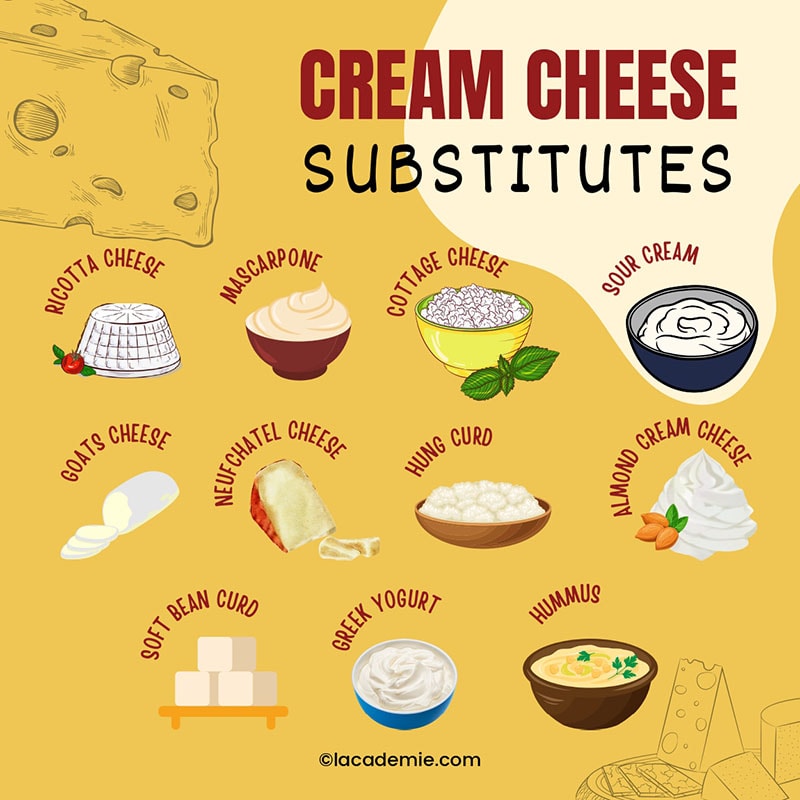
What Is Cream Cheese?
First, understanding cream cheese will help you choose the right product to replace it. Cream cheese is a type of fresh, white, soft type of cheese.
Cream cheese has a mild and sour taste, so the dishes using cream cheese are fat but not greasy. It is an incredibly familiar ingredient used in cakes and bakery recipes, and interestingly, both grilled and savory dishes.
The composition of cream cheese contains many protein and milk fats, usually cow’s milk, which are used in cooking and baking. Cream cheese has a greasy taste with a slightly sour and savory flavor.
Other than the traditional cream cheese, you can also notice different cream cheese types with vastly different flavors. There’s the chocolate cream cheese for fans of fudgy flavors, strawberry cream cheese for those preferring a fruity taste in their cheese, etc.
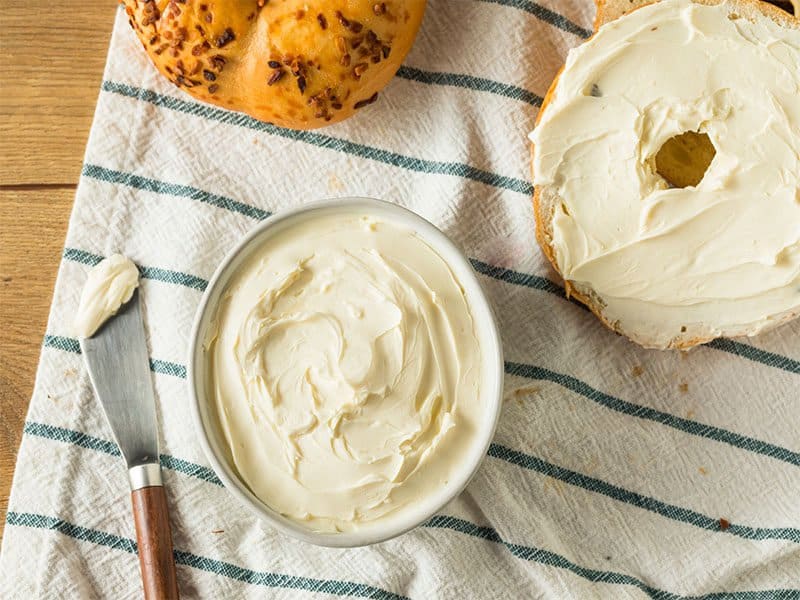
What Is Cream Cheese Used For?
Talking about the use of cream cheese, I am most impressed with this cheese is deliciousness and greasy taste that it brings to the dishes and cakes when using this ingredient.
Delicious cakes like Cheesecake fragrant, Cheese Souffle, Red Velvet, Carrot Cake or Cherry Cheesecake, etc., have become many times more attractive.
The flavor and high fatness of cream cheese make the cake more fragrant but do not spoil it. Besides, this type of cheese is often used to eat fresh with bread or make cake decorating.
Not only used to make cakes, but cream cheese is also used in some recipes. Cream cheese is a very familiar ingredient used in recipes to make desserts such as cheese souffle, cheesecake, or eaten with bread and used to decorate drinks and other dishes.
In addition, cream cheese is also used as an ingredient in recipes, making the dish more delicious, with moderate fat and very attractive, such as bacon with cream cheese sauce and pasta, cream cheese, and chicken with dried tomatoes.
Nutrition Of Cream Cheese
In general, 1 ounce of cream cheese provides:
- Calories: 99
- Protein: 2 grams
- Fat: 10 grams
- Carbs: 2 grams
- Fiber: 0 grams
- Vitamin A: 10% of the Daily Value (DV)
- Riboflavin (vitamin B2): 5% of the DV
Health Benefits Of Cream Cheese
Cream cheese contains several nutrients that provide health benefits, such as:
Provide Antioxidants
Cream cheese can be seen as a source of antioxidants that protect your body. It will help you prevent the risk of some chronic diseases like heart disease, cancer, or diabetes.
Provide Vitamin A
As noted above, cream cheese contains a significant amount of vitamin A. Vitamin A is fat-soluble and contributes to improving your eyesight. It also helps you with better immunity and protects your body’s tissues.
Less Lactose Than Milk
Cream cheese is low in lactose, so people with lactose intolerance or lactose allergy can still eat a small amount of cream cheese every day without difficulty.
Somethings To Note About Cream Cheese
Cream cheese is delicious and helpful, but there are also a few things to consider:
Contains A Lot Of Saturated Fat
Cream cheese contains very high-fat content. However, most of it is saturated fat which can be harmful to your health if consumed excessively. It can raise cholesterol in the blood.
Low In Protein
Cream cheeses are extremely low-protein cheeses in the cheese family, compared to goat cheese or something else.
Short Shelf Life
Cream cheese has a relatively short shelf life, and you must consume it quickly. Usually, the cream cheese’s shelf life on the market will be 7-10 days after you open the lid. And cream cheese’s shelf life when left at room temperature is even shorter.
Cream Cheese Substitutes
Therefore, if you need some cream cheese substitutes to avoid these problems, I will help you. You can also check to see if cream cheese is freezable to rectify these issues. But for now, let’s see 14 great substitutes to replace cream cheese that you will hardly notice the difference.
1. Ricotta Cheese
Ricotta is a cheese from Italy made from water separated from cow’s milk or sheep’s milk. Since it resembles cream cheese in terms of taste, you can use it as a substitute in low-fat cake recipes.
When processing, separating the cream to make the watery cheese is separated, the same water is used to make the Ricotta cheese. Ricotta cheese is white, quite soft, slightly sweet, and very low in fat. You will often find ricotta cheese in delicious frozen lasagna.
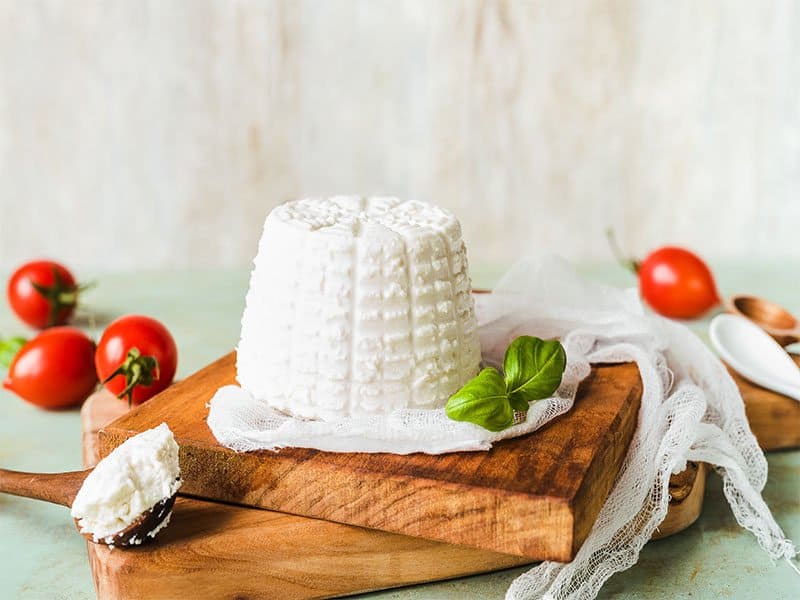
Benefits
Each serving of Ricotta also contains more phosphorus, another mineral that plays a major role in bone health.
It will maintain bone development and integrity.
Besides, protein in the ricotta cheese can help you meet your daily needs if you mix it with other foods in your meals. Ricotta can also help you reduce the risk of high blood pressure due to the rich phosphorus content.
This delicious cheese is also great for healthy weight loss diets. Not only low in calories, but it is also high in essential amino acids that your body needs.
Uses
This type of cheese is very popular for Italian desserts or with other desserts. In addition, Ricotta cheese is also used to make cheesecake, cookies, or put in Pasta or Pizza, etc.
With a little bit of foreign cheese that is fragrant and moderately fatty, you can absolutely use Ricotta as a side dish with fruits, biscuits, and, more especially, spices to make pasta.
2. Mascarpone
Mascarpone is the name for a fresh cheese that is prized for its softness. However, Mascarpone is not classified as cheese because there is no normal fermentation in cheese. However, it can still be used well as a substitute for cream cheese.
Mascarpone is considered a preparation made up of an additive ingredient and during the separation of cream from milk and is coagulated with citric or acetic acid after denaturing the separated aqueous portion without pressing or waiting.
As a substitute for butter, this liquid cheese has a rich aroma and is easy to use. In order to get the exact flavor of the cakes, Mascarpone is an irreplaceable ingredient.
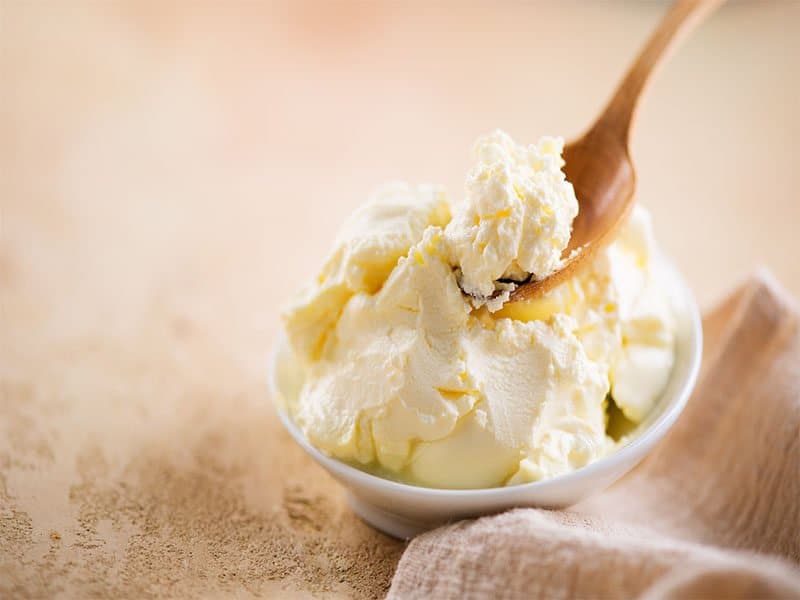
Benefits
Mascarpone contains vitamin A which contributes to your vision, immune system, iron absorption for energy. It also contains calcium to specialize and contribute to your energy creation, muscle function, and digestion.
The riboflavin found in Mascarpone is for energy. Vitamin B12 will improve your mental health. It also promotes immune system function, healthy cell division and reduces fatigue.
The iodine in Mascarpone contributes to thyroid health, energy requirements, and the nervous system and promotes children’s normal development.
Uses
Mascarpone is used as an important ingredient in baking. You can use it to make cream cakes or other cakes. You can replace cream cheese with Mascarpone and vice versa.
Among the most widely beloved desserts featuring mascarpone is Tiramisu, a dessert from Italy. A soft, cool, and creamy cream that dissolves quickly in the mouth when used is the Mascarpone cake’s typical feelings.
Besides, it is also often used to accompany some desserts or fruits to add fat and deliciousness. It is also used to make creamy soups. When using Mascarpone, there is no need to perform baking or heat cooking to increase the creaminess and aroma of soups.
3. Cottage Cheese
When it comes to the taste of cottage cheese, it seems that people either love it or dislike it. Either way, there’s no denying that cottage cheese is a good substitute for cream cheese. And the many vitamins and essential nutrients it can provide make it a great addition to daily meals.
Cottage cheese is made from pasteurized milk; besides, this cheese can also be made from fatty milk. People often pack Cottage cheese into many different sizes to suit each user’s needs.
Since Cottage cheese is considered a fresh cheese, it does not undergo aging or needs to be cooked to improve flavor. Therefore, the taste of Cottage cheese is not as strong as other types of cheese.
In terms of nutritional composition, Cottage cheese contains many nutrients, including vitamins B1, B3, B6, vitamin A, and other essential minerals. This type of cheese is considered a great dish to combine with the menu of dieting.
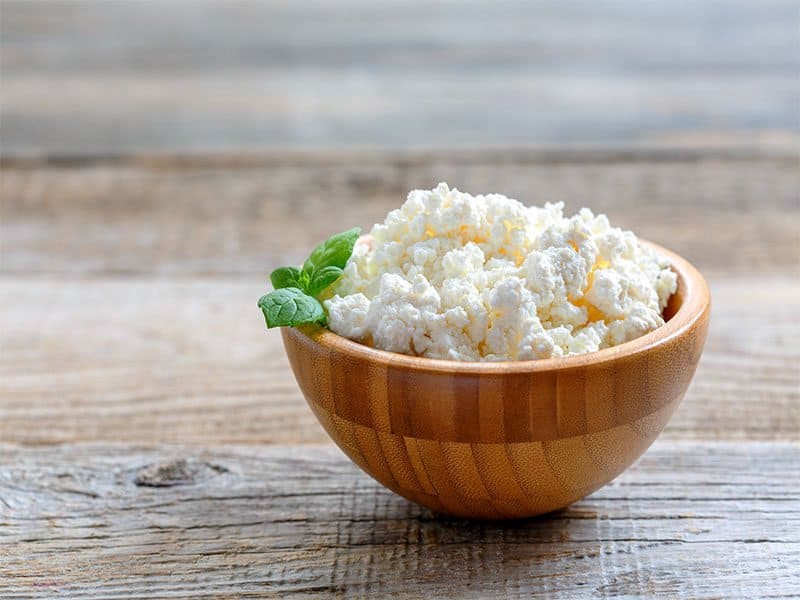
Benefits
Cottage cheese is a food that not only contains many nutrients for the body to help you hunt muscles and implement a better weight loss regime. Very suitable for bodybuilders, sports athletes, malnourished people, and rickets children.
Cottage cheese is available in cream and whipping. So you can enjoy it by using it directly or as ingredients for dishes and cakes.
Cottage cheese provides many vitamins B1, B3, B6, and a large amount of Vitamin A, other essential minerals that are good for the body.
Moreover, the amount of protein in Cottage cheese is large because it is very suitable for malnourished patients or patients who do not eat much.
Uses
Cottage cheese has a mild flavor. The soft texture of home cheese makes it great to be used in meals, recipes, and baking like toast, pancake, or waffle.
It’s also great to mix with fruit like berries with sliced bananas, add a few slices of peaches, mandarin and melon to mix well and serve.
Alternatively, you can add Cottage cheese to your favorite salads to add more protein. Mixing this cheese well into sauces or smoothies is also great as a substitute for cream cheese.
4. Sour Cream
Sour cream is a dairy product obtained during the fermentation of whipped cream with certain types of beneficial lactic acid bacteria. The name comes from the production of lactic acid by bacterial fermentation.
Sour cream contains fats and thickeners such as Gelatin, Rennet as well as acidic acids. Sour cream has a mild, low-fat, sour fragrance that contains less butter because it is only made from milk and cream.
This material is not completely fermented. Sour cream does not freeze or separate at high temperatures, so it can be used in cooking and perfectly suited to use in cakes or salads when you do not have cream cheese.
People with gluten intolerance might be asking “Is there gluten in sour cream?” before adding this ingredient to their diet. Worry not, sour cream is gluten-free most of the time.
Sour cream helps cakes taste better, not greasy like when using Whipping cream. Cake covered with Sour Cream will keep the form, cream is smooth, supple, and has a firmer texture than whipping.
Due to its characteristic sour taste, sour cream is often used to reduce the dish’s fatness or give the dish the desired sour taste. It is also commonly used to flavor frozen meatballs.
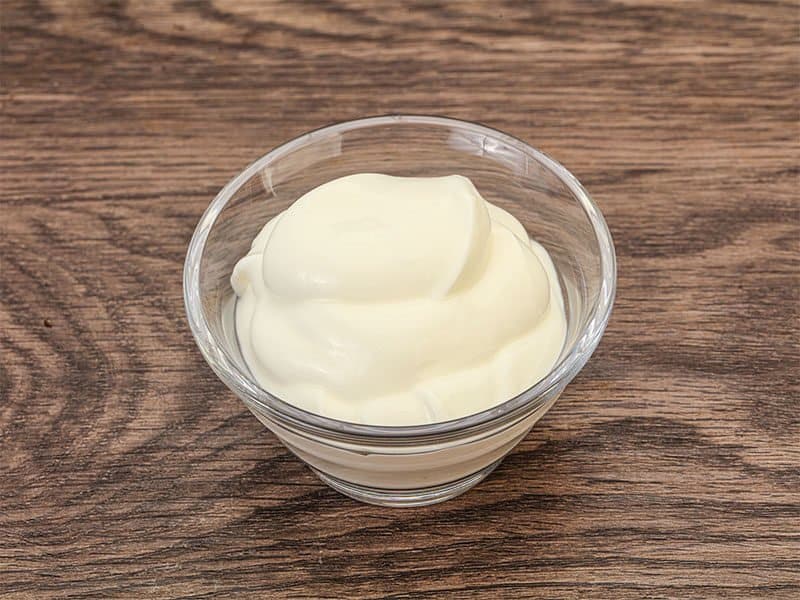
Benefits
Some vitamins need fat for the most effective absorption. Sour cream will help the body to promote the absorption of these fat-soluble vitamins because sour cream is mainly composed of fat.
Sour cream helps provide probiotics to the body because sour cream is fermented with lactic acid bacteria to create a sour taste, this probiotics will benefit our intestines and digestive system.
Uses
Sour cream is a creamy sauce with a particularly smooth, silky fragrance that is great for sweet and savory dishes such as baking, salad dressings, and desserts.
Sour cream is also used primarily as a spice or as a substitute for breakfast. It serves as a topping with baked potatoes. Sour cream is also used in mixes for cakes, cookies, donuts, and baked goods.
When using sour cream with salads or fresh fruit, it will make the dish more attractive and taste much better. The delicious taste of sour cream makes the dishes more special and attractive. In addition, sour cream is also used as an ingredient in the preparation of beverages.
5. Goats Cheese
Goat cheese is made from goat’s milk, containing a variety of probiotics. The beneficial bacteria in goat milk are friendly bacteria that benefit your health in a variety of ways. A diet rich in probiotics has been shown to boost digestive health, reduce inflammation and boost immunity.
Goat cheese is a food that provides an outstanding amount of probiotics thanks to its high-fat content and hard texture, helping to protect beneficial bacteria from external influences. Goat’s milk is safer than cow’s milk in many ways but has a relatively similar flavor.
Therefore, you can completely use goat cheese as a substitute for cream cheese because it is relatively similar and safer for the body. Choose cooked goat cheese or those made with whole, raw, raw milk.
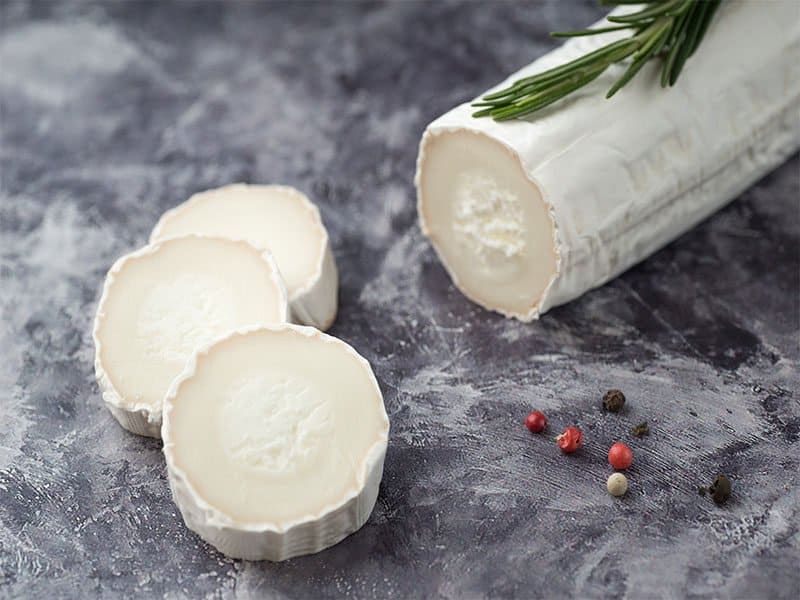
Benefits
Many people find that the switch from cow’s milk products to goat milk products helps stop the digestive system from discomfort.
This is because goat milk products, including cheese, have a different protein structure from cow’s milk products and lower in lactose.
Because containing less lactose than cow’s milk, goat’s milk may be a better choice for those suffering from malaise.
What’s more, like other dairy products, goat cheese is an excellent source of calcium. Please support your body to increase this mineral supplement if you do not eat many green vegetables, nuts, or a lot of seafood.
Along with protein and fat, goat cheese also provides phosphorus, copper, vitamin B6, and iron. The combination of protein, calcium, and iron can help support bone formation and encourage the body to absorb certain minerals better.
Besides, goat’s milk is higher in medium and short-chain fatty acids than cow’s milk. These fatty acids will be digested quickly, providing energy almost immediately, thereby soothing the feeling of a scratch in the stomach.
Uses
Goat cheese has a particularly rich flavor that enhances the taste of every dish. It works best when you replace it with cream cheese in dips or pasta sauce. Goat cheese is also suitable for making cheese truffles, which are delicious appetizers for serving cold.
6. Neufchatel Cheese
Although there are quite a few differences that set cream cheese and Neufchatel apart, their somewhat similar flavor means you can use them interchangeably in some recipes.
In fact, Neufchatel cheese comes from France. Neufchatel cheeses actually use whole milk and not cream. In France, Neufchatel cheese is just cream cheese.
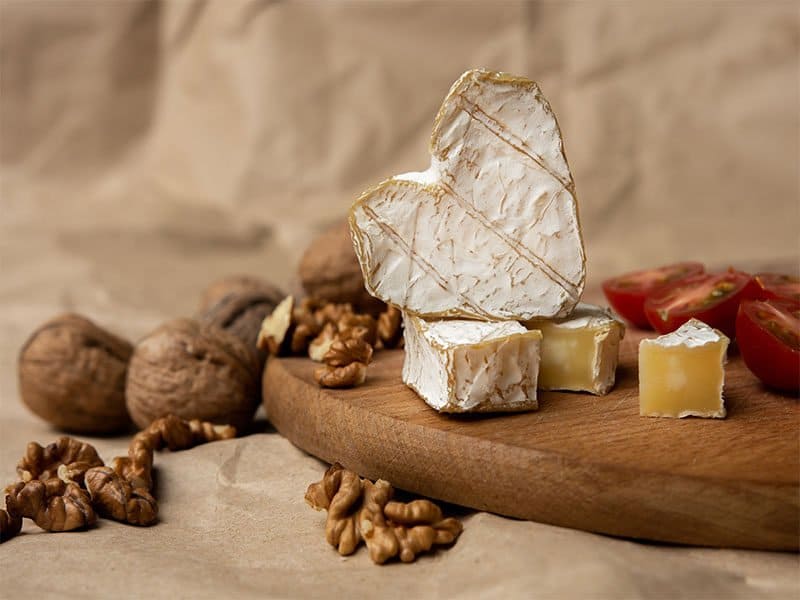
Benefits
Neufchatel has lower fat content than cream cheese. Many people consider Neufchatel cheese to be a mild version of cream cheese. This is a soft and, at the same time, unripe cheese.
Moreover, Neufchatel also has more protein than cream cheese. However, these values may vary depending on the process, the additional ingredients to create a certain Neufchatel preparation.
Eating Neufchatel, you will not have to eat too many calories but very nutritious. You can spread this cheese on a muffin or mix it with cucumber and tomato.
Uses
Neufchatel is great for replacing cream cheese when used in recipes, especially when making savory dishes. You will hardly notice any difference!
7. Hung Curd
Hung Curd is a dish made from cow’s milk that can substitute for cream cheese. It is fermented milk but does not taste like our regular yogurt. Curd has a slight taste, excess sourness, lack of sweetness.
Hung curd is used as a staple dessert and is very popular in India. The hung curd has a tofu-like surface with a warm sweetness and ginger aroma.
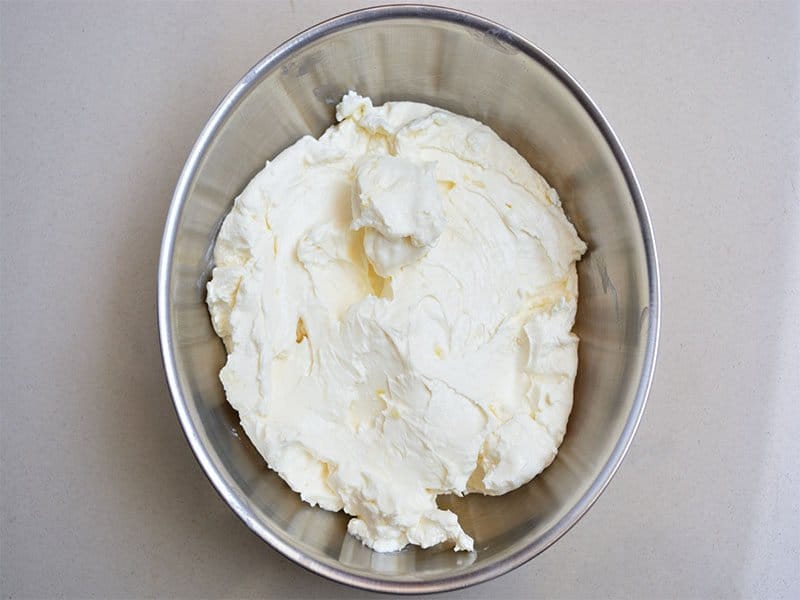
Benefits
Hung curd enhances immunity. It provides nutrients such as Vitamin K and Lactobacilli and stimulates an increase in B and T white blood cells in the human body.
Hung curd works to reduce the level of Cortisol in the blood, which is a hormone that regulates the accumulation of fat around the abdomen and heart. Besides, hung curd also limits cravings for fast food, helps you control your diet, and supports a lot of weight loss processes.
Hung curd is rich in calcium and phosphorus, both of which are essential minerals to maintain your teeth and bones’ strength. This is because the curd reduces the number of harmful bacteria in the mouth.
Uses
Hung curd is a versatile cream cheese substitute that can be used even in pastries and baked goods.
8. Cashew Or Almond Cream Cheese
Cashew or Almond Cream Cheese is an excellent cream cheese substitute, and you can’t tell it apart. It is made primarily from almond milk and a thickener for creamy flavors and flavors without milk.
This almond/cashew cheese is very fatty, a bit sour, and has a slightly salty taste and a bit of garlic flavor. The almonds and cashews are finely mixed, making it perfect as a cream cheese substitute.
Since it’s made from plants, even vegans can enjoy this dairy-free product. It will give a luxuriously creamy finish, a slightly salty, lifelike flavor.
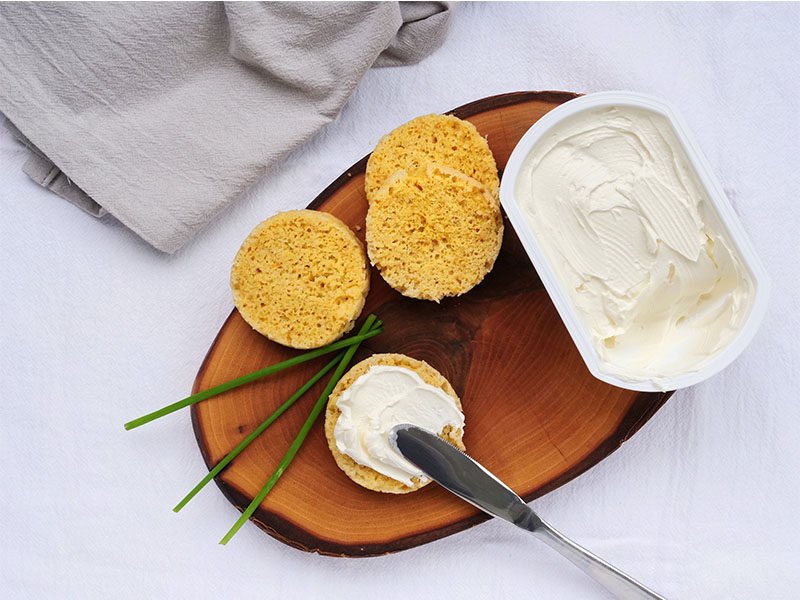
Benefits
With some nutritional differences, almond cheese or cashews has some great benefits over cream cheese: fewer calories contain more good fats and still provides adequate protein. It is truly nutritious for vegetarians.
Uses
If you want to make light, dairy-free desserts like Cheesecake, Fruit Pizza, this will be a great choice. Cashew or Almond Cream Cheese can also be easily added to soups and sauces. You should also use this if you are spreading bagels or baking.
Furthermore, you can freeze this cheese in the refrigerator and use it as a substitute for cream cheese in equal proportions in any recipe like pies and sandwiches.
9. Soft Bean Curd
Soft bean curd or tofu is a food made from soy milk consisting of soybeans, water, and a thickening ingredient pressed into white solid blocks. It has a processing process similar to that of making cheese.
Soft bean curd has a mild flavor, which means it absorbs the flavor of anything cooked or cooked with. Soft bean curd has had a permanent foothold on store shelves as a meat substitute for vegetarians and vegans.
Therefore, you can use soft bean curd as a substitute for cream cheese in savory recipes as well as desserts that require cream cheese. Not only does it taste good, but it’s also very nutritious.
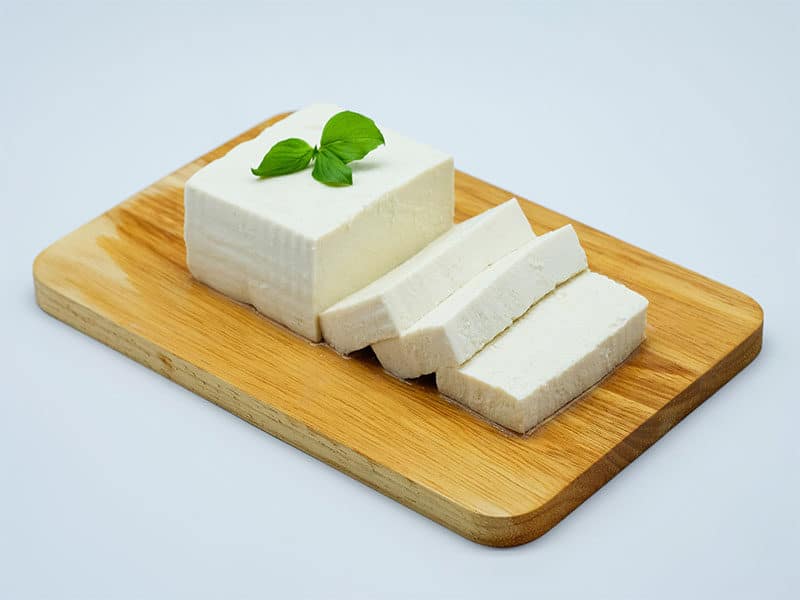
Benefits
Soft bean curd is also high in soy protein and calcium, which is ideal for plant-eaters to get core nutrients. It also contains all the essential amino acids your body needs. It also contains fats, carbs, and a variety of vitamins and minerals.
In addition, Soft bean curd does not contain saturated fat, contributing to heart disease, high blood pressure, and other diseases. You will really need the Soft bean curd if you want a healthy heart.
Soft bean curd is known to be high in calcium. This is an important nutrient that supports children’s development and is also important for women at high risk of osteoporosis.
Furthermore, the soft bean curd contains iron, copper, and manganese in its composition. These nutrients help the body absorb them from each other, create clean meals, and increase energy for the body.
Uses
You can use a soft bean curd to top with morning toast. Using it to make some small scones is just as great. Using it in your savory recipes and desserts instead of cream cheese is also a great choice.
10. Greek Yogurt
Unlike many popular yogurts in the market, Greek yogurt has completely different ingredients and flavors. However, you can still use it as a substitute for cream cheese to create a new flavor for your dish.
If you don’t want to find Greek yogurt, you can totally do it yourself, and it is at home with these convenient and compact greek yogurt makers. This method is both safer and more cost-effective.
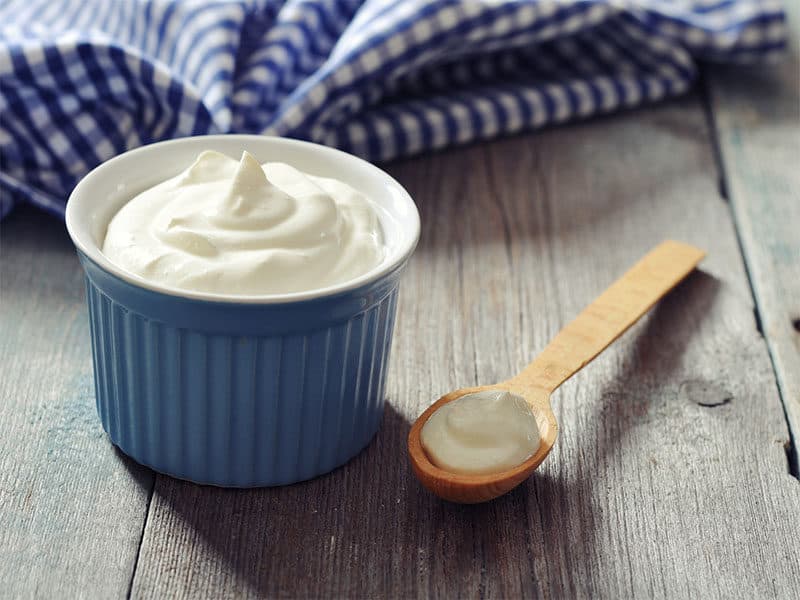
Benefits
Unlike regular yogurt, Greek yogurt contains a higher protein and nutrients but low cholesterol and fat content, almost none. Therefore, this is a food that brings a lot of benefits to our muscles and heart.
Using Greek yogurt regularly, you have effective weight control, a healthy brain, stable blood pressure, strong bones, etc.
Not only good for health, but Greek yogurt also possesses a delicious taste. Yogurt is white, has a soft texture, and is thick. Light sour taste mingles with a fatty taste that fits the mouth, creating a hard to refuse attraction.
Uses
You can use Greek yogurt for baking or make a marinade. It is also great to eat with fruit and vegetables. In place of cream cheese, it does a fine job of increasing the spicy dishes’ appeal.
11. Kefir
This is a lactic fermented food thanks to lactic acidophilic bacteria and yeast fermentation, rich in enzymes with beneficial bacteria that help balance the digestive system. It is a great nutritional choice to replace cream cheese in sauces and side dishes.
This KefirKefir is a living organism that eats fresh milk and produces yeast that is very beneficial to the body. Mushroom milk works to strengthen the body’s immune system, restore weak functions. Kefir is shaped like scorching rice, soft, transparent white, and fragrant.
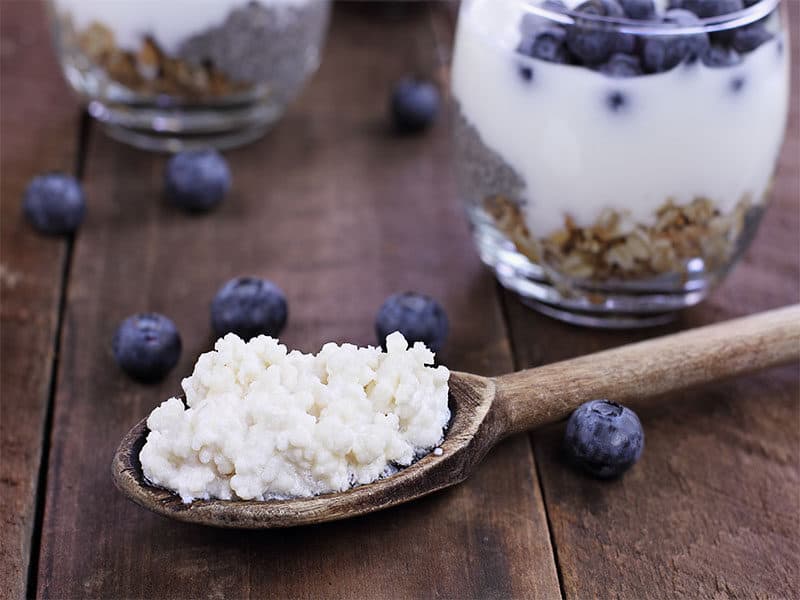
Benefits
The refreshing taste and characteristic sour taste of fermented dairy products bring beneficial bacteria to the user. In Kefir, Lactobacillus Caucasus, Leuconostoc, Acetobacter species, and Streptococcus species, these are beneficial bacteria that are not present in yogurt.
Besides, KefirKefir contains many beneficial enzymes such as Saccharomyces kefir and Torula kefir. These two enzymes penetrate the mucous membrane, where beneficial bacteria remove harmful bacteria and strengthen the intestinal tract.
The beneficial yeasts and bacteria in KefirKefir provide more nutritional value, which is considered more beneficial for the digestive system. It is especially nutritious and suitable for babies, the elderly, people who are tired and often have digestive disorders.
Uses
To use KefirKefir as a substitute for cream cheese, you will need something to achieve a thicker, more viscous mixture, such as chia seeds. Kefir is a bit thin, so it is best used for dips and savory dishes rather than desserts or cakes.
12. Hummus
Hummus’s main ingredient is chickpeas combined with tahini sauce (sesame butter), olive oil, lemon juice, salt, and garlic. This sauce is originating from Arab sauce with a characteristic salty, fatty, and frugal flavor, harmonizing the ingredients.
If you’re wondering whether hummus suits a vegan diet, the answer is yes, most of the time. However, because it contains many spices, you should only use hummus to make sauces or dips for savory dishes to replace cream cheese. You won’t want to use it for baking!
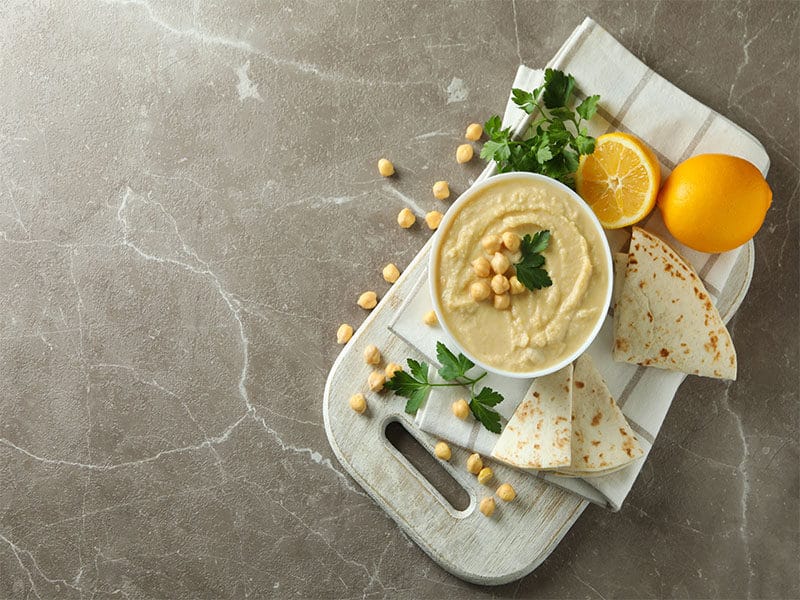
Benefits
Hummus is very suitable for vegetarians when it provides a lot of protein – a nutrient that seems to be only abundant in meat and fish. Not only that, but the use of hummus also provides you with other nutrients with a considerable amount.
The indispensable ingredient in hummus is olive oil – a miracle ingredient rich in antioxidants with effective anti-inflammatory properties.
Not only olive oil but sesame seeds in tahini fever also reduce the inflammatory markers in the body that often appear in arthritis.
Some of the fibers in hummus can be converted by gut bacteria into the short-chain fatty acid butyrate. This fatty acid is good for colon cells and may help reduce the risk of colon cancer.
Hummus is also rich in protein, resistant starch, and antinutrients, making hummus a food that keeps blood sugar regulated and a great source of soluble fiber and good fats.
These good fats help slow the digestion of carbs and slow the absorption of carbs from the gut, thus releasing sugar into the bloodstream more slowly and steadily.
The use of hummus can also reduce cardiovascular diseases. With criterion 3 no: gluten-free, seedless, and dairy-free, hummus does not cause any allergies. It is easy for people to consume this dish without having to worry.
Uses
With a smooth and rich aroma, hummus, when combined with vegetables, fruits, meat, or eggs, will form a delicious, soft, and beautiful sandwich.
Instead of using ketchup, you can also spread a thin layer of hummus on the pizza’s top. Surely this new and special combination will make you excited.
The pita bread has the same shape as the pizza base and is cut into slices to taste, dipped with hummus to make the cake, simple but special and delicious than ever.
Not only does it make your salad look more appealing and smoother, but hummus also provides an even greater amount of protein and fiber. Just a little hummus is enough to make your salad more rich, delicious, and not boring.
The combination of the refreshing sweetness of apples and the fatty salty taste of hummus will make your taste buds burst with this irresistible deliciousness.
Do you fear that there’s a possibility of hummus going bad? Then you can put the hummus inside an airtight container and store it inside the fridge.
13. Vegan Cream Cheese
If you are on a vegetarian diet and want to change the vegan cereal you eat every day with a delicious cake, why not choose cream cheese vegan?
Not only is this a great alternative, but it also contains less fat and no cholesterol than cream cheese made from milk. It’s also truly cream cheese, so you won’t have to fret.
You can find vegan cream cheese at any store or order it online. You can also make your special vegan cream cheese at home.
Benefits
Innovative new dairy-free vegan cream cheese made with superfood coconut oil, nutritious nuts, and other plant-based proteins. It still retains the delicious taste of cream cheese.
Vegan cheese is a more sustainable alternative to milk-based cream cheese and more allergen-friendly options for people sensitive to milk or the lactose in milk.
Uses
The usage of vegan cream cheese is the same as regular cream cheese, and you can apply it to any dish you want.
14. Homemade Cream Cheese
Although there are many alternatives, you can still take the time to make cream cheese manually to save quite a bit. To help you get delicious, nutritious, and cheap cream cheese bowls, I will introduce you to the simple way to do it at home.
Prepare 1 liter of milk, 2 yogurt cartons, and 1 filter bag.
Cream cheese making process:
- Place 1 liter of sugary milk in a small saucepan.
- Then, put it on the stove to boil over the heat for about 5-7 minutes, enough to make the milk warm and not boil.
- When the milk is warm, add 2 cans of yogurt and stir well
- When the yogurt is completely dissolved in sweetened milk, turn off the heat and empty it into a clean jar and cover it tightly.
- Put the water in the rice cooker or foam barrel in the ratio of 1 cold: 2 hot.
- Then put the glass jar containing the milk and fresh milk mixture just collected and incubate for 5-7 hours.
- Then wait until the mixture solidifies into yogurt
- Scoop this mixture into a filter bag and seal. Place the small bottle below to stand the water dripping from the filter bag – this is cream cheese.
- Let the mixture drip for about 7-8 hours, cream cheese in the filter bag comes out. At this point, you can use it immediately.
Making cream cheese is a bit time-consuming, but the way to do it is not too complicated so that you can make it at home, both cost-saving and quality assurance.
FAQs
Do you have any questions about the best alternatives to cream cheese? Chances are you will find the answer to your question below:
Expectation & Reality – Should Cream Cheese Replace?
Whatever your reason, there is no substitute for cream cheese without changing the flavor of your food. Thanks to cream cheesecakes, they have a unique flavor, so it isn’t easy to find a completely similar ingredient to replace.
However, if you need, you can still replace cream cheese and accept some very small food flavor changes. I have presented you with great replacements for almost no difference!
Now that you know all the most similar and nutritious products for cheesecake substitutes let’s try if my recommendation is right. After that, don’t forget to leave a comment below this post to share with me!
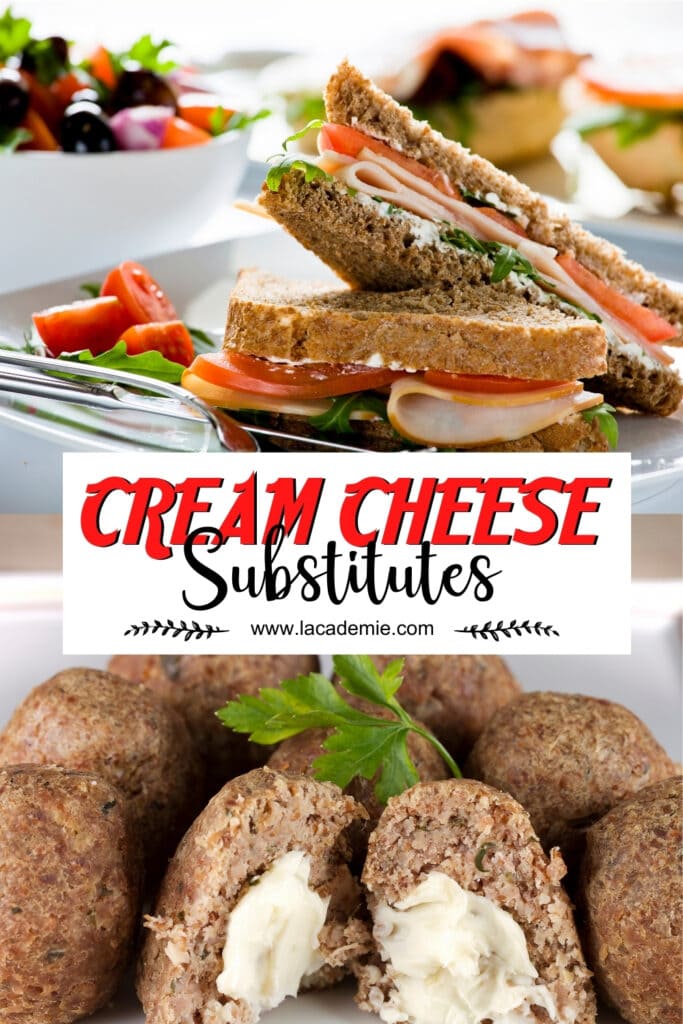


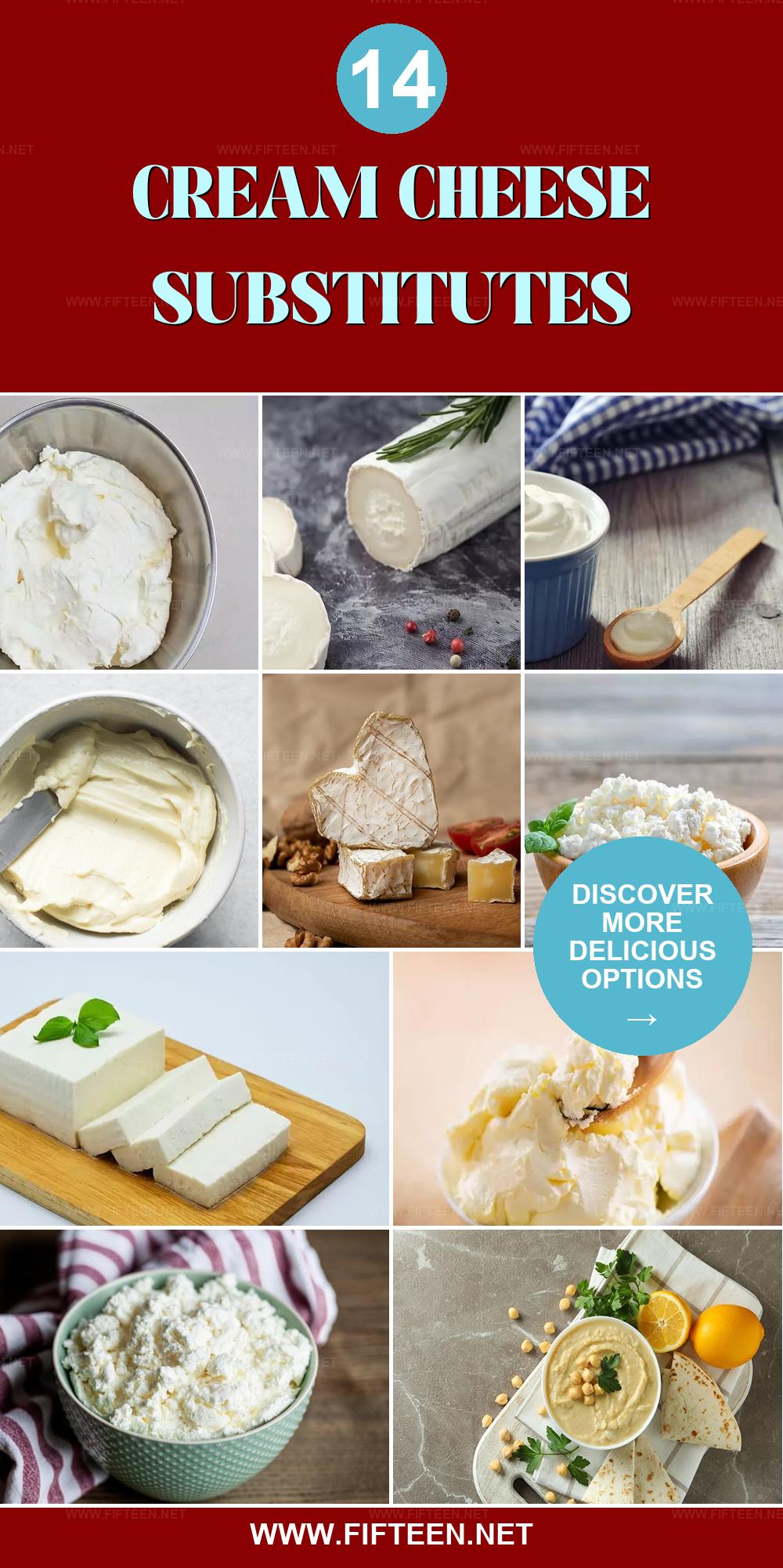
Jamie Scott
Editor in Chief, Senior Content Writer
Expertise
Home Cooking, Meal Planning, Recipe Development, Baking and Pastry, Food Editor, Cooking-video Maker, Western Food Evaluation Expert
Education
Le Cordon Bleu College of Culinary Arts
Local Community College, New York, NY
Jamie Scott is a skilled culinary expert and content creator specializing in Western cuisine. With over 15 years in the culinary field and formal training from Le Cordon Bleu, Paris, Jamie deeply understands how to blend nutrition with delicious flavors. His passion for cooking matches his commitment to making healthy eating accessible and enjoyable.
On Fifteen.net, Jamie brings a fresh perspective to classic dishes and beverages, offering readers insightful recipes, cooking tips, and a fresh view on meal planning that emphasizes taste, health, and simplicity.